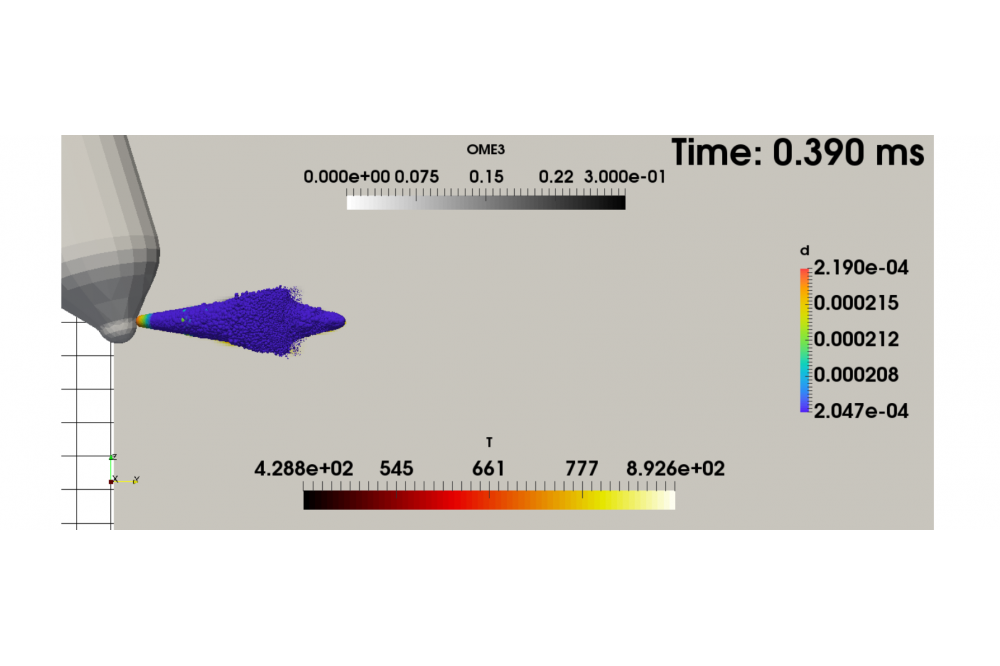Spray Combustion of the New Synthetic Fuel Oxymethylenehter (OME)
Einleitung
3D computational fluid dynamics (CFD) simulations are nowadays an established method in science and a tool in industrial combustion process development. Especially, in the early phase of product development, it can be used to evaluate the influence of geometry variations and modified components on combustion and pollutant formation. Especially if expensive test bench programs, partly with prototype hardware, can be reduced by using 3D-CFD simulation, significant time and cost advantages result. However, a prerequisite for this is that the underlying models can reliably describe the internal engine physical and chemical processes. In this con-text, spray combustion models based on detailed chemical kinetics and their coupling with local mixing processes have become established for diesel engine combustion in both science and industry. For the 3D-CFD spray combustion simulation of the novel e-fuel polyoxymethylene (OME), this necessarily means that models are needed both for the chemical kinetics of the OME pure substances and blends and for the interaction of chemical reactions and transport processes during ignition and combustion.
Methoden
The fuel injection process in modern diesel engines is a complex two phase problem. The cause effect chain (Injection-Evaporation-Mixing-Combustion) is strongly coupled and needs a variety of models to capture the physical and chemical modes of action. For the numerical discretization method the finite volume method (FVM) is utilized. The so called Navier-Stokes-Equation is solved in order to solve the flow field. Additionally, equations for energy, chemical reactions and evaporation are solved. The gaseous phase is solved in eulerian coordinates and the liquid phase is described by lagrangian particles that interact with the gas phase. Each particle, a so-called parcel, represents a number of droplets that share the same properties (temperature, size, velocity). The coupling between parcels and gas phase involve momentum and evaporation source terms.
In spray combustion the mixture formation is an important quantity. The quality of the mixture field determines the accuracy of the combustion and pollutant formation simulation. Therefore, high fidelity Large Eddy Simulations (LES) are frequently used in literature. A large amount of the turbulent structures/eddies are resolved (high grid resolution), only a smaller amount of turbulence has to be modeled using appropriate turbulence models. The combustion model used in this project is the so-called flamelet model, which allows speeding up the simulation significantly. The idea behind the flamelet model is that a flame structure can be represented by a manifold of one dimensional flame structures, so-called flamelets. The great advantage of the flamelet model lies in the ability to precompute the flamelet solutions for all relevant thermochemical states and store them in look up tables. During the simulation the chemical source terms can be looked up, instead of solving expensive differential equations, using appropriate access variables.
Ergebnisse
This project is related to the national research program, that investigates new technologies in the transport sector (”Energiewende im Verkehr”). In the subproject ”E2Fuels” the renewable synthetic e-fuel polyoxymethylene (OME) is under investigation. In this project phase thermophysical properties for polyoxymethylene (OME3 and OME4) could be implemented and first spray simulations be conducted. In Fig. 1 a Large Eddy Simulation (LES) of OME3 is displayed. The comparison of the vapor and liquid penetration lengths of simulation and experimental measurements show good comparison during the first phase of injection.
Diskussion
In Fig. 1 a good agreement between simulation and measurements can be seen. The simulation did not finish yet, therefore the simulation has to be finished. Due to a significant increase vapor pressure of OME3 in comparison to e.g. n-Dodecane, break up parameters have to be further investigated. Furthermore, reactive simulations with different kinetic mechanisms are planned for the next project phase.




